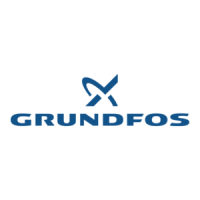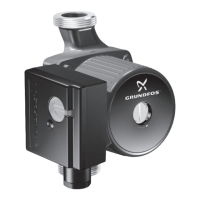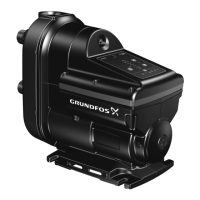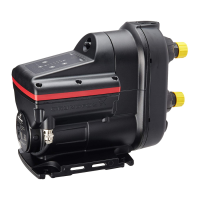English (GB)
13
3.2.2 Frequency converter operation
All SE1, SEV pump types are designed for frequency
converter operation to keep the energy consumption
at a minimum.
For frequency converter operation, please observe
the following information:
Requirements must be fulfilled.
Recommendations ought to be fulfilled.
Consequences ought to be considered.
Requirements
• The thermal protection of the motor must be
connected.
• Minimum switching frequency: 2.5 kHz.
• Peak voltage and dU/dt must be in accordance
with the table below. The values stated are
maximum values supplied to the motor terminals.
The cable influence has not been taken into
account. See the frequency converter data sheet
regarding the actual values and the cable
influence on the peak voltage and dU/dt.
• If the pump is an Ex-approved pump, check if the
Ex certificate of the specific pump allows the use
of a frequency converter.
• Set the frequency converter U/f ratio according to
the motor data.
• Local regulations or standards must be fulfilled.
Recommendations
Before installing a frequency converter, calculate the
lowest allowable frequency in the installation in order
to avoid zero flow.
• Do not reduce the motor speed below 30 % of
rated speed.
• Keep the flow velocity above 1 m/sec.
• Let the pump run at rated speed at least once a
day in order to prevent sedimentation in the
piping system.
• Do not exceed the frequency indicated on the
nameplate. In this case there is risk of motor
overload.
• Keep the power cable as short as possible. The
peak voltage will increase with the length of the
power cable. See data sheet for the frequency
converter used.
• Use input and output filters on the frequency
converter. See data sheet for the frequency
converter used.
• Use a screened power cable if there is a risk that
electrical noise can disturb other electrical
equipment. See data sheet for the frequency
converter used.
Consequences
When operating the pump via a frequency converter,
please be aware of these possible consequences:
• The locked-rotor torque will be lower. How much
lower will depend on the frequency converter
type. See the installation and operating
instructions for the frequency converter used for
information on the locked-rotor torque available.
• The working condition of bearings and shaft seal
may be affected. The possible effect will depend
on the application. The actual effect cannot be
predicted.
• The acoustic noise level may increase. See the
installation and operating instructions for the
frequency converter used for advice as to how to
reduce the acoustic noise.
4. Starting up the product
SE1 and SEV pumps are suitable for the following
operating situations:
• Dry installation without separate motor cooling.
• Submerged installation
– S1 operation (continuous operation).
The pump can operate continuously without
having to be stopped for cooling.
– S3 operation (intermittent operation).
S3 operation is a series of identical duty cycles
(TC) each with a constant load for a period,
followed by a rest period. Thermal equilibrium
is not reached during the cycle.
Maximum repetitive peak
voltage
[V]
Maximum dU/dt U
N
400 V
[V/μ sec.]
850 2000
The pump must not run dry.
Dry running can cause ignition hazard.
Do not open the clamp while the pump is
operating.
Do not start the pump if the atmosphere in
the pit is potentially explosive.
The pumps are fitted with impellers of S-
tube
®
design. S-tube
®
impellers are wet
balanced which will reduce the vibration
during operation. If the pumps are started
with the pump housing full of air, the
vibration level will be higher compared to
normal operation.
Local balancing of S-tube
®
impellers will
damage the wet balancing and lead to
higher vibration levels during operation.
The pumps are designed for continuous
operation, both for submerged and dry
installation.

